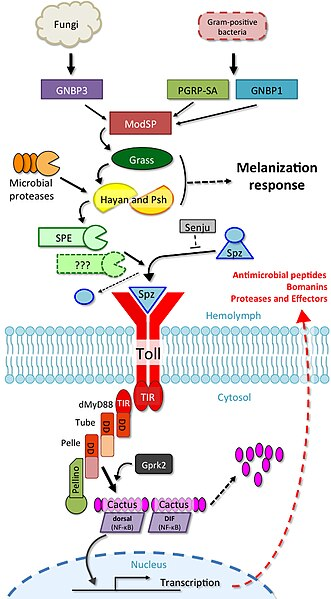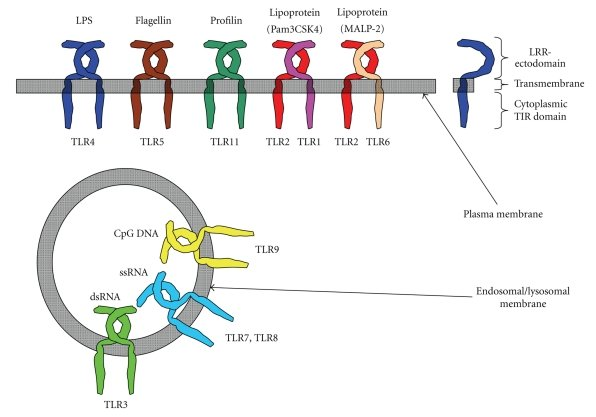The innate immune system acts as the body's first line of defense against invading pathogens. Toll-like receptors (TLRs) are crucial components, specifically recognizing conserved molecular patterns on microbes. The discovery of TLRs, achieved through decades of research, significantly improved our understanding of immune activation and opened doors for novel therapeutic approaches.
Get detailed insights in this PDF:
Fruit Fly Research Leads the Way:
The foundation for TLR discovery came from research in the fruit fly, Drosophila melanogaster. In 1985, Christiane Nüsslein-Volhard and Eric Wieschaus identified a mutant gene named "Toll" while studying embryonic development in flies. This mutation caused a specific body patterning defect, highlighting Toll's importance in proper development.
From Flies to Humans: Identifying TLRs
The significance of Toll extended beyond fly development. Sequence comparisons revealed a strong similarity between Toll and a human gene located on chromosome 4. This human counterpart was subsequently named the "Toll-like receptor" (TLR) due to its functional resemblance to the fly protein. This discovery opened a new avenue for investigating TLRs in human immunity.
Unraveling TLR Function:
Building on this knowledge, researchers like Charles Janeway Jr. and Bruce Beutler made significant contributions in understanding TLR function. They demonstrated that TLRs on immune cells could recognize specific components of bacteria, such as lipopolysaccharide (LPS). This recognition triggered a signaling cascade, ultimately leading to the production of pro-inflammatory cytokines and the activation of immune defenses.
A Nobel Recognition:
The groundbreaking work on TLRs culminated in the well-deserved 1995 Nobel Prize in Physiology or Medicine being awarded to Nüsslein-Volhard and Wieschaus for their discovery of the Toll gene in Drosophila. This recognition solidified the importance of TLRs in immunology and fueled further research into their diverse functions.
TLRs: Beyond Microbial Recognition
The discovery of TLRs has had a profound impact on biomedical research. Today, we recognize a family of 13 TLRs in humans, each with distinct ligand specificities. TLRs not only recognize microbes but also play a role in responses to endogenous ligands released by stressed or dying cells, known as damage-associated molecular patterns (DAMPs). This versatility positions TLRs at the center of innate immunity, linking sterile inflammation to pathogen defense.
The Enduring Legacy of TLRs:
The discovery of TLRs remains a landmark achievement in immunology. Their role in immune activation has opened doors for the development of novel therapeutic strategies. TLR agonists are being explored as vaccine adjuvants to enhance immune responses, while TLR antagonists hold promise for controlling excessive inflammation in autoimmune diseases. As TLR research progresses, we can expect even more exciting discoveries that will reshape our understanding of immunity and pave the way for the development of next-generation therapies.
Find out more in this interview:




![TLR signaling induced in host cells upon interaction with fungal pathogens. Surface Toll-like receptors (TLRs), as well as endosomal TLRs participate to the recognition of fungal PAMPs [e.g., O- and N-linked mannans, phospholipo-mannan (PLM), glucuronoxylomannan (GXM), α-mannosides, β-glucans, DNA, and RNA]. Activation of surface TLRs involves their homo- (TLR4) or hetero-dimerisation (TLR2/TLR1 or TLR6). The diversity of signaling pathways is increased by the involvement of co-receptors of the C-type lectin family (e.g., SIGNR1 and Dectin-1) or Galectin-3. Confirmed physical interactions between PRRs are represented by double-head arrows. The integration of simultaneously activated signaling pathways occurs at the level of intracellular adaptors and transcription factors shared between overlapping pathways. The resulting cytokine responses shape the activation of the adaptive response and ultimately modulate the outcome for the host. This figure was adapted from Bourgeois et al. (2010) by including newly published data from Biondo et al. (2012) and Takahara et al. (2012), and as reviewed in Romani (2011) and Leibundgut-Landmann et al. (2012). A. fumigatus, Aspergillus fumigatus; C. albicans, Candida albicans; Candida spp, Candida species; C. neoformans; Cryptococcus neoformans; M. furfur, Malassesia furfur. TLR signaling induced in host cells upon interaction with fungal pathogens. Surface Toll-like receptors (TLRs), as well as endosomal TLRs participate to the recognition of fungal PAMPs [e.g., O- and N-linked mannans, phospholipo-mannan (PLM), glucuronoxylomannan (GXM), α-mannosides, β-glucans, DNA, and RNA]. Activation of surface TLRs involves their homo- (TLR4) or hetero-dimerisation (TLR2/TLR1 or TLR6). The diversity of signaling pathways is increased by the involvement of co-receptors of the C-type lectin family (e.g., SIGNR1 and Dectin-1) or Galectin-3. Confirmed physical interactions between PRRs are represented by double-head arrows. The integration of simultaneously activated signaling pathways occurs at the level of intracellular adaptors and transcription factors shared between overlapping pathways. The resulting cytokine responses shape the activation of the adaptive response and ultimately modulate the outcome for the host. This figure was adapted from Bourgeois et al. (2010) by including newly published data from Biondo et al. (2012) and Takahara et al. (2012), and as reviewed in Romani (2011) and Leibundgut-Landmann et al. (2012). A. fumigatus, Aspergillus fumigatus; C. albicans, Candida albicans; Candida spp, Candida species; C. neoformans; Cryptococcus neoformans; M. furfur, Malassesia furfur.](/web/image/41735-04d2cdec/image.png?access_token=d409add3-5a55-4518-aeb7-e2ac8fe3edfd)
Toll-Like Receptors (TLRs): Discovery, Function, and Impact on Immunology